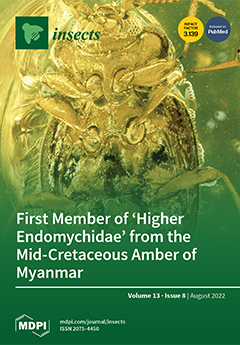Entomopathogenic nematodes play a pivotal role as biocontrol agents for different species of insect pests, including the red palm weevil. In the current investigation, the infective capabilities of four species of entomopathogenic nematodes, including
Hetrerorhabditis bacteriophora,
Steinernema feltiae,
Steinernema glaseri,
[...] Read more.
Entomopathogenic nematodes play a pivotal role as biocontrol agents for different species of insect pests, including the red palm weevil. In the current investigation, the infective capabilities of four species of entomopathogenic nematodes, including
Hetrerorhabditis bacteriophora,
Steinernema feltiae,
Steinernema glaseri, and
Steinernema carpocapsae, were evaluated against larvae, pupae, and adult red palm weevil under laboratory and field conditions. The pathogenic potential of selected nematode species was assessed based on dissection and adult emergence of weevils. Our results indicated that
S. carpocapsae and
H. bacteriophora, with a respective 94.68 and 92.68% infection rate, were the most effective EPN species against red palm weevil larvae. Focusing on adult emergence, the aforementioned EPNs were comparatively less pathogenic and resulted in 63.60 and 60.20% infested pupae, respectively. It is noted that adult emergence is the better option to evaluate the pathogenic potential of EPNs, compared with the dissection of insects. The
S. carpocapsae was found to be most effective against the 6th instar larvae of the red palm weevil and caused 100% mortality at 240 h after treatment. On the other hand,
S. glaseri and
S. feltiae were found to be the least pathogenic and caused 70 and 76% mortality, respectively. All of the evaluated nematode species were found to be highly infective under field conditions. The
S. carpocapsae was found to be the most pathogenic, causing 83.60% mortality of the red palm weevil. However, the tested nematodes were found most effective against larvae, followed by adult weevils, but their effect was minimal against the pupae of red palm weevils. Based on these findings, we conclude that the
S. carpocapsae and
H. bacteriophora could be used as a sustainable option for the efficient management of the red palm weevil.
Full article






